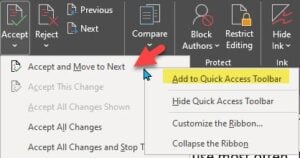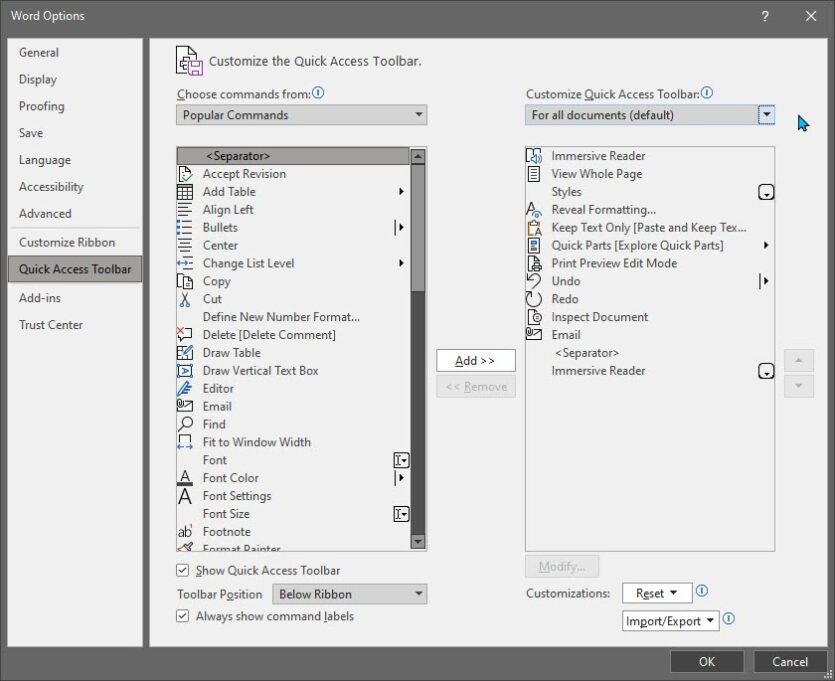MS Office Hack: The Quick Access Toolbar
If you live in Microsoft Word, Outlook, PowerPoint, and Excel you can customize the Ribbon with the QAT (Quick Access Toolbar) to add contextual commands at your fingertips. How can you take advantage of this feature, including use of the particularly useful “Commands Not in the Ribbon”? Read on!
What is the Quick Access Toolbar (QAT)?
The QAT is a customizable toolbar that has been in every version of the Microsoft Office applications (Word, Outlook, PowerPoint, Excel) since the Ribbon appeared in MS Office 2007. The Ribbon replaced the toolbars in Office, consolidating them and making it easier to navigate the extensive features in the software. However, the Ribbon reduced the ability to customize the tools that you use most often. The QAT brings some of that customization back, though you can also customize the Ribbon if you choose to do so.
Viewing the QAT
The QAT appears above the Ribbon by default, though you can easily display it below the Ribbon. If you don’t see it, you may need to enable it. In any of the Office suite software go to File – Options – Quick Access Toolbar. At the bottom of the resulting window make sure the box is checked for “Show Quick Access Toolbar”. Below that you can choose to show the toolbar position above or below the Ribbon. More recent versions of Office have added tools like search, versions, and autosave above the Ribbon so it may be easier to see below the Ribbon. Make sure “Always show command labels” is checked so you have a description to go with the symbols for functions.
The QAT only appears in Microsoft Office installed software. If you are a Microsoft 365 subscriber and using the browser versions of Office, there is no QAT.
Adding Tools to the QAT
Once you have the QAT enabled and positioned where you want it you will see there are some commands enabled by default. It is easy to remove those commands from the QAT. At the end of the QAT click the down arrow. You can toggle on or off the default tools by checking and unchecking the commands.
 Want to add tools from the Ribbon to the QAT? Right (alternate) click on a tool in the Ribbon and from the resulting drop-down menu choose “Add to Quick Access Toolbar”. For instance, in the Review tab of the Ribbon go to the Changes group and mouse over “Accept”. Click on the arrow below “Accept” to see the options including “Accept and Move to the Next”, “Accept All Changes”, and “Accept All Changes and Stop Tracking”. Right click on any of these options and add it to the QAT. Now instead of digging around the Ribbon for the command next time you get a marked-up document you can begin your review with the click of a button.
Want to add tools from the Ribbon to the QAT? Right (alternate) click on a tool in the Ribbon and from the resulting drop-down menu choose “Add to Quick Access Toolbar”. For instance, in the Review tab of the Ribbon go to the Changes group and mouse over “Accept”. Click on the arrow below “Accept” to see the options including “Accept and Move to the Next”, “Accept All Changes”, and “Accept All Changes and Stop Tracking”. Right click on any of these options and add it to the QAT. Now instead of digging around the Ribbon for the command next time you get a marked-up document you can begin your review with the click of a button.
Advanced QAT
While there are some limitations (you can only add commands to the QAT, but not formatting like indent and spacing values and individual styles) there is a lot you can add to the QAT. Add commands by either going to File – Options – Quick Access Toolbar or click on the down arrow at the end of the QAT and choosing “More Commands”. The default commands – and there are a LOT of them – are Popular Commands. Click on the drop-down menu below “Choose commands from” and you can also view options from “Commands Not in the Ribbon” and “All Commands”. You can also go to specific tabs depending on which application you are customizing to add commands that might be hidden behind smart menus that are only enabled when you select words or images and right click. For instance, many of the Smart Art and Chart Tools are difficult to find or do not appear until certain criteria are met. You can unearth them by adding them to the QAT.

Some QAT commands may not appear in the Ribbon until they can be used. These are contextual commands. For instance, if you add the handy “Resend This Message” to the QAT it will not appear in the toolbar until you have opened a sent message. This is useful because the QAT doesn’t get cluttered with useless commands. Where is “Resend This Message”? Open a message from your Sent folder and in the Move group click on “More Move Actions” and right click on “Resend This Message” and add it to the QAT. Or you can open the QAT dialog box and look under All Commands – Resend This Message. When you click “Resend This Message” you can change the subject line and recipients, making it quicker than copying and pasting the text and setting up another email.
Depending on what add-ins you have you may be able to add commands to the Quick Access Toolbar from an add-in. For instance, if you have Simply File installed you can find the command to “Batch File” in All Commands in the QAT dialog box.
You can change the order of the commands in the QAT. Open the QAT dialog box by going to File – Options – Quick Access Toolbar or clicking on the arrow at the end of the QAT toolbar and choosing “More Commands”. Select a command and move it up or down with the arrows on the far-right side.
QAT to Try Out
In MS Outlook
Close All Items – closes all open emails, tasks, events, and contacts that open and proliferate throughout the day. If you have a message or event in draft, it will prompt you to save or send it. Open the QAT dialog box, choose “All Commands” and scroll to “Close All Items”.
Automatic Replies – to set up your out of office or automatic reply options open the QAT dialog box and choose “Automatic Replies” from the Popular Commands.
Show Focused Inbox – In Outlook you can toggle between seeing all your messages, or show Focused Inbox, which divides your inbox into two tabs – Focused and Other. To toggle between them open the QAT dialog box, look in All Commands and choose Show Focused Inbox.
In MS Excel
Format – see all formatting options, including changing cell size, Hide/Unhide rows and columns, organize and protect sheets and more by choosing Format in All Commands in the QAT dialog box.
Freeze panes – Freeze rows or columns. In the QAT dialog box choose “Freeze Panes” from Popular Commands.
In MS Word
Print Preview Edit Mode – you can open a print preview mode in Word that lets you edit the document before you print. This is useful for one last review before you hit the print button as it shows you how the printed file will look and lets you edit it if necessary. Open the QAT and look for it in Commands Not in the Ribbon.
Inspect Document – want to quickly remove metadata, comments, tracked changes, and macros before you share a Word document? Add Inspect Document from the QAT dialog box from All Commands.
Immersive Reader – if you need to edit your own work the Immersive Reader will help you focus on the document by showing only a few lines at a time, read aloud, and increasing the font size without changing the document. This tool is in All Commands.
In MS PowerPoint
New Slide – if you want to add a new slide and choose the theme add “New Slide” from the Popular Commands in the QAT dialog box.
Reuse Slides – insert slides from other slide decks without messing up the formatting. Reuse slides opens a dialog box that lets you search for slide decks and shows recent slide decks and drop in slides as necessary or insert them all. Make sure “use source formatting” is checked so you don’t have to fix the slide formatting, as they will adopt the formatting of the new deck. Reuse Slides is in Popular Commands.
Spelling – you might not think about running a spell check on a slide deck – until you see a glaring typo during a presentation. Spelling also checks your speaker’s notes in case you are planning to share those as well. Spelling is in Popular Commands.
From Beginning – if you find yourself searching for the tiny button in the Status Bar to start a slide show or fumbling around going to the Slide Show tab to start the slide show from the beginning just add it to your QAT! From Beginning is in Popular Commands.
Other Customizable Toolbars in MS Office
In addition to the QAT, and customizing the Ribbon itself, you also have the Status Bar at the bottom of the screen in the MS Office applications. In MS Word you can see number of pages, number of words, whether track changes are on or off, and increase Zoom in or out. In Outlook you can see the number of emails and unread emails in a folder, how many reminders you have and whether Outlook is connected to Exchange Server. You can customize the Status Bar by mousing over it and right clicking. You can toggle on and off different tools, though you can’t add any new ones.
Conclusion
You can really speed up your work by customizing the Quick Access Toolbar, as well as reduce the frustration of not being able to find a command in the Ribbon easily. Peruse the options in Commands Not in the Ribbon and All Commands to find some power tools you might not even know you had! If you value screen real estate you can load up your QAT, learn some keyboard shortcuts (mouse over commands in the ribbon and tool tip will often show a keyboard shortcut), customize your Status Bar and you may even be able to minimize the Ribbon!
